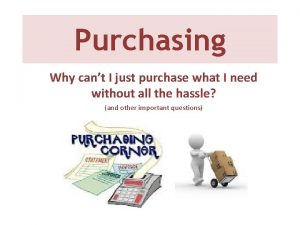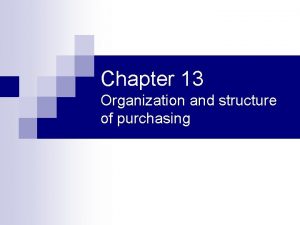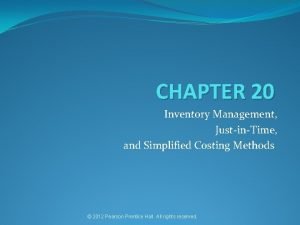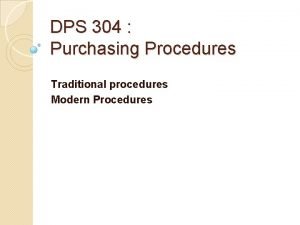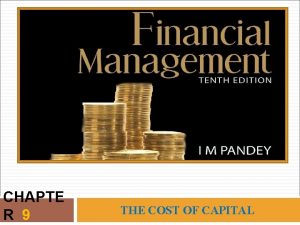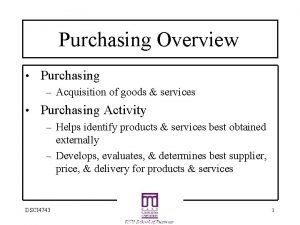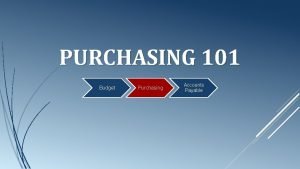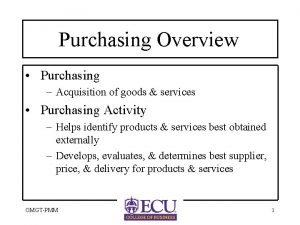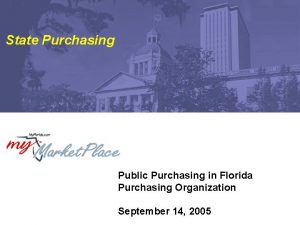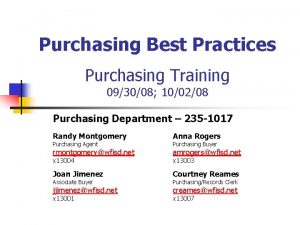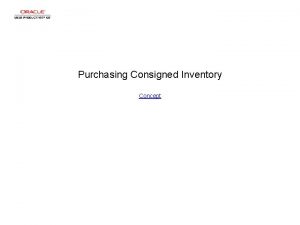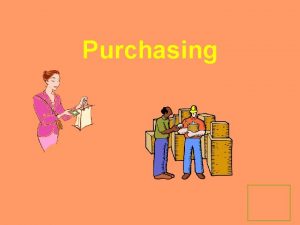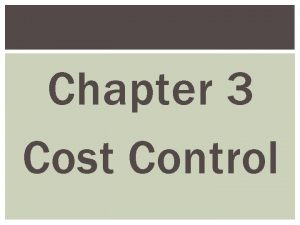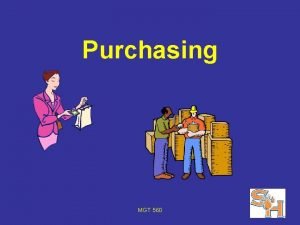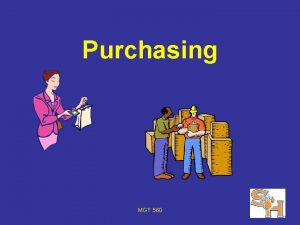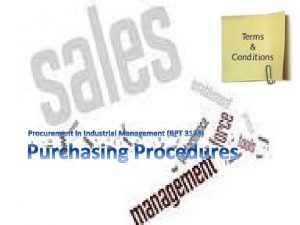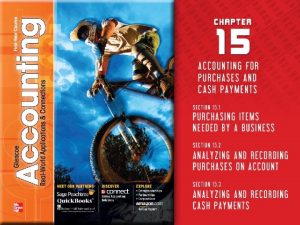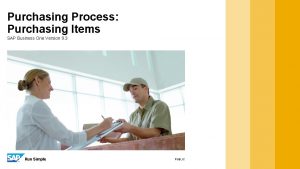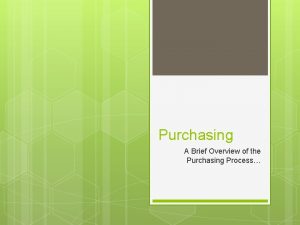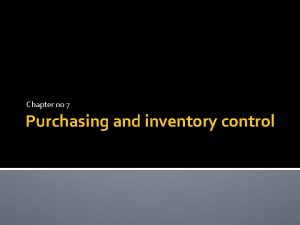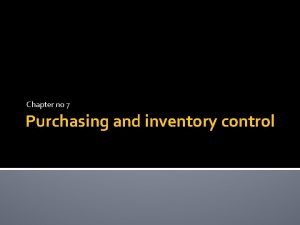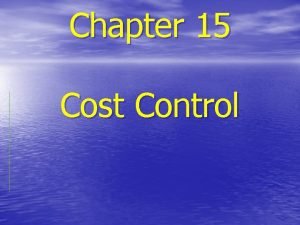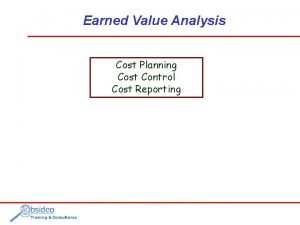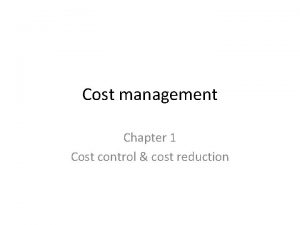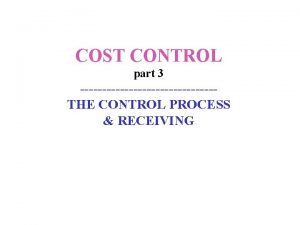COST CONTROL part 2 THE CONTROL PROCESS PURCHASING
























- Slides: 24

COST CONTROL part 2 ---------------THE CONTROL PROCESS & PURCHASING

THE CONTROL PROCESS & PURCHASING Who is in Charge & Responsible? Goal: ensure a continuing supply of sufficient (quantity) of the necessary foods with the required quality and at the best price. Focus: develop standards for quality/quantity/price Depending on size and culture of operation, can be: --> owner, chef, purchasing dept. , steward Critically Important Steps • determination of quality standards • development of standard purchase specs.

THE CONTROL PROCESS & PURCHASING Food Categories/Types of Foods Purchased Drives the frequency & quantity of Purchasing & Costing • Perishable food (frequent orders in limited quant) Typically fresh foods that have a comparatively short useful life after they have been received / Direct Issue • Nonperishable food (less frequent orders in larger quant) Items, often referred to as groceries or staples, that have a longer shelf life / Stores YOUR OWN EXAMPLES ?

THE CONTROL PROCESS & PURCHASING Food Categories/Types of Foods Purchased Drives the frequency & quantity of Purchasing & Costing • Categorizing Importance Has to do with the • • • Amount purchased Frequency of purchase Cost treatment in food cost calculations Some factors --> Location/ seasonality/ type of operation

THE CONTROL PROCESS & PURCHASING Establishing Quality Standards & Standard Purchase Specifications helps insure all F&B purchased will be of the desired quality for their intended use. • Basis is the menu • Define degree of excellence of Raw Materials ü cans/beef/seafood/eggs/organic/Scotch/Champagne • Decisions Re: brand, size, grades, freshness, delivery • Consistent products require consistent raw materials • Ideally, for each and every purchased item • Goal: Standard Purchase Specification • based on owner/chef/manager’s experience • Federal gov. grading specs &/or industry standards

Advantages of Standard Purchase Specifications 1. Forces managers to determine exact requirements in advance for any product 2. Useful in menu preparation 3. Eliminates misunderstandings between stewards and purveyors 4. Circulation of specifications for one product to several purveyors makes competitive bidding possible 5. Eliminates the need for detailed, verbal descriptions of a product each time it is ordered 6. Facilitates checking food as it is received Makes sure that everyone is on the same page

Standard Purchase Specifications

THE CONTROL PROCESS & PURCHASING Establishing Quantity Standards & Procedure Need to be continually revised, probably with each order. Goal: Determine appropriate quantity for each item • based mainly of useful life of item • deal with measures ü weight/volume/count/ for buying & selling portions & labor control • historical usage data and covers forecast are helpful • foods are divided into perishables and non perishables • Purchasing procedures differ for each category

PERISHABLES By definition, use what you have before buying more • Determine quantity on hand vs. what will be needed ü quantity needed (to meet future needs) --> par/par stock/min-max • The above should be done daily (by steward) ü Cost/Benefit- what is steward’s time worth ü Use Market Quotation List ü should be listed in order they are stocked ü could include fruits/veg/meat-poultry/seafood • Then based on needs, place order ü chef/kit manager is best one to supply the needs

PERISHABLES + AMOUNT NEEDED (par) - AMOUNT ON HAND then order the difference PAR >> quantity you require to meet anticipated needs in some specific upcoming time period. Other definitions of PAR >> # of units & time related > max. quantity of an item to have on hand at all times > quantity that should be on hand at ALL times > min-max range that varies

PERISHABLES Steward Market Quotation List example of a standard form (a very useful tool)

NONPERISHABLES Not issue of quality deterioration like perishables but a “cash tie up” • Goal: should be a “pull system” like Toyota’s JIT ü excess inventory is today’s business poison (theft/emps/space) ü maintain appropriate level using infrequent order method • Storeroom controls ü labels on shelves & permanent locations • Market Quotation Lists not normally used • Question arises-when to reorder and how much to order ü Periodic order method -Most common method -Can have regular order dates with fixed intervals (1/week) ü Perpetual inventory method - Like a checkbook >> a running balance BUY ONLY WHAT IS NEEDED~ANTICIPATED

NONPERISHABLES - Con’t • How to anticipate quantity needed for next period ü guess √ good memory ü supplier records √ bin cards (text 119) • Bin Cards ü on the shelf (2 x purpose) records each IN & OUT instance ü useful info: item size/vendor/last price ü verify on-hand with physical count ü important Order Quantity considerations § one component “desired ending inventory (DEI)” (lag time) - calculated using daily usage & delivery time § one component “safety margin” (extra biz) - Usually 50% or 100% of (normal usage x delivery time) • Cost/Benefit ü lots of record keeping required = a non-revenue expense

Periodic Order Method for Nonperishables • storage space a factor • company inventory policy a factor • the 2 important quantities are • Normal usage (historic data) • Desired ending inventory • they will vary the menu/weather/etc + – + = Amount required for the upcoming period Amount presently on hand Amount wanted on hand at the end of the period to last until the next delivery Amount to order Must constantly review 2 quantities: Normal Usage & DEI

Periodic Order Method for Nonperishables Usage = 7 cans / week ==> 1 can / day Delivery time = 5 days Ordering for 2 weeks How we arrived at DEI of 10 cans ?

Periodic Order Method for Nonperishables Usage = 7 cans / week ==> 1 can / day Delivery time = 5 days Ordering for 2 weeks

Perpetual Inventory Method for Nonperishables • Purpose ü Ensure sufficient but not excessive quantities ü Provide effective control of items in storage • Implementation ü Uses Perpetual Inventory Card (manual or computerized) ü Negative side is that can require daily ordering • Perpetual Inventory Card ü Like Bin Card, but kept “remote” from storeroom location • better control b/c not maintained by storeroom staff • additional Info: reorder point / par stock / reorder quantity ü Reorder point • requires normal usage+delivery time+safety margin • = Desired Ending Inventory (DEI) of the Periodic Method ü Par stock (amount needed to meet anticipated needs in some period) • To establish must consider following CONSTRAINTS

Perpetual Inventory Method for Nonperishables Par Stock Quantity Constraints 1. 2. 3. 4. 5. Storage space (less is better) Limits on total value of inventory prescribed by management (cash flow) Desired frequency of ordering Usage Purveyors’ minimum order requirements (pack size/delivery) ü Reorder Quantity • Quant. that will be reordered when the Reorder Point reached. • Quant. should bring Total Inventory up to the Par Stock level. + Par Stock 15 (text pg 122) - Reorder Point 10 (or DEI) = Subtotal 5 (difference) + Normal usage until delivery 5 (1/day x 5 days : add back in) = Reorder Quantity 10 (12 cans b/c come 6/case) when delivered, inventory will be 16 cans or near Par Stock


Perpetual Inventory Method for Nonperishables GENERAL FORMULA Par stock Reorder point = Subtotal + Normal usage until delivery = Reorder quantity NOTE: Hybrid Method - Process used must be based on needs of organization - (+) perpetual > better control (records kept outside of storeroom) - (-) perpetual > requires daily ordering - (-) periodic > comparative absence of control Most common Hybrid Reorder points and pars set high enough that they function only as a signal that on next scheduled order day item needs to be reordered.

THE CONTROL PROCESS & PURCHASING Establishing PRICE Standards Recall: Purchase Standards (specifications) give Quality to Buy Inventory Procedures give Quantity to buy • CONSIDERATIONS § Purveyors (Suppliers/Vendors) ü Sources are Critically Important (supplier credit) ü best to use a mix based on size/mgmt preferences/organization’s finances ü will always be a trade off decision wholesalers local producers manufacturers packers local farmers retailers coops importers

THE CONTROL PROCESS & PURCHASING Establishing PRICE Standards (con’t) • CONSIDERATIONS § Price Quotations ü compare prices from various vendors ü best way to insure most favorable price (all else being equal) ü phone/fax/mail/sales rep. visit/online/direct computer link - to obtain prices & place orders (purchase) ü Quote Frequency - Perishables: prices change daily but quoted for a week - Nonperishable: about the same process § Purchasing Decisions ü more of a cost/benefit decision ü who &/or how many purveyors wanted delivery time > reliability > # of items carried ü local competition places big role in choices available

Centralized Purchasing Used by chains and coops created for independents Advantages 1. Foods and beverages can be purchased at lower prices because of volume 2. Desired quality can be obtained more readily because the purchasing agent has a greater choice of markets 3. Foods can be obtained that meet the purchaser’s exact specifications 4. Larger inventories can be maintained, ensuring reliable supply to individual units 5. The possibilities for dishonest purchasing in individual units are greatly reduced

Centralized Purchasing (con’t. ) Trade off: lower prices for not having decision making power Disadvantages Almost always requires a distribution infrastructure 1. Each unit must accept the standard item in stock and has little freedom to purchase for its own peculiar needs 2. Individual units may not be able to take advantage of local “specials” at reduced prices 3. Menus are ordinarily standardized, limiting the individual unit manager’s freedom to change a menu STANDING ORDERS (2 MAIN TYPES) {usually bread & milk] 1. Delivery Of Specific Quantity Daily 2. Replenishing up to a predetermined number (PAR)
 Emergency purchase
Emergency purchase Purchase department structure
Purchase department structure The basic eoq model ignores the purchasing cost.
The basic eoq model ignores the purchasing cost. The flow of costs in job order costing
The flow of costs in job order costing Cost control and cost reduction difference
Cost control and cost reduction difference Cost control and cost reduction difference
Cost control and cost reduction difference Cost control and cost reduction project report
Cost control and cost reduction project report Cost control and cost reduction project report
Cost control and cost reduction project report Modern purchasing process
Modern purchasing process Product control and process control
Product control and process control Cost accumulation and cost assignment
Cost accumulation and cost assignment Cost accumulation and cost assignment
Cost accumulation and cost assignment Manufacturing cost vs non manufacturing cost
Manufacturing cost vs non manufacturing cost Job costing and process costing
Job costing and process costing Flotation cost in cost of equity
Flotation cost in cost of equity Manufacturing cost vs non manufacturing cost
Manufacturing cost vs non manufacturing cost Cost pools
Cost pools Manufacturing cost vs non manufacturing cost
Manufacturing cost vs non manufacturing cost Standard cost vs budgeted cost
Standard cost vs budgeted cost Opportunity cost of equity capital
Opportunity cost of equity capital Cost accumulation and cost assignment
Cost accumulation and cost assignment Standard costing process
Standard costing process Literal cost gate input cost
Literal cost gate input cost Distinguish between average cost and marginal cost
Distinguish between average cost and marginal cost Ordering cost and carrying cost
Ordering cost and carrying cost
